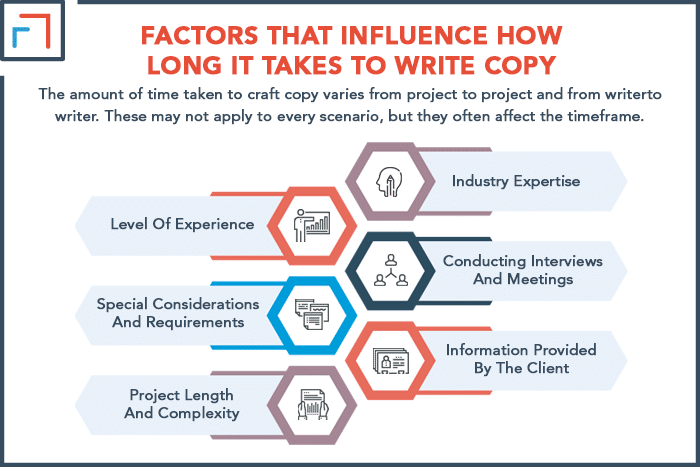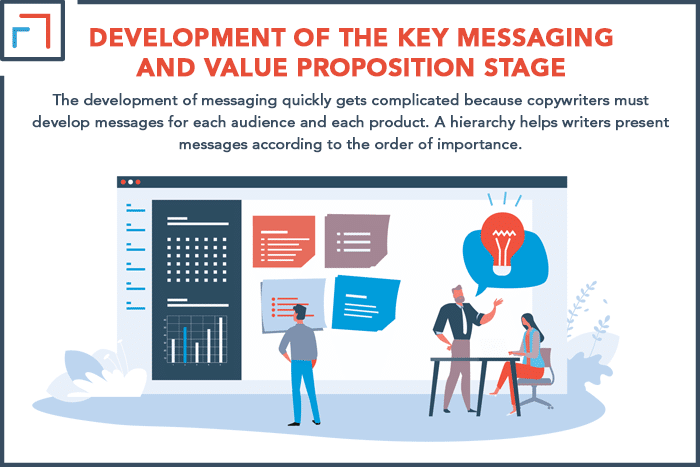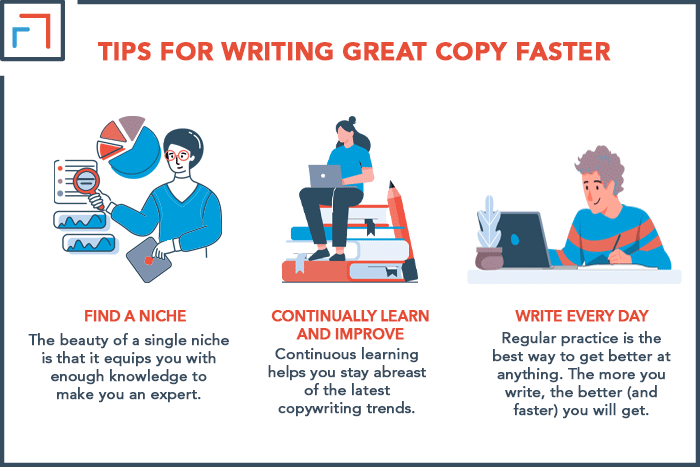Understanding the timetable of copywriting helps you set realistic deadlines and produce copy that converts. Whether you hire a copywriter or do the work yourself, it’s good to know how long it takes to write copy.
Writing good copy can take anywhere from 1 hour to a few weeks. The time frame depends on several factors, including project length and complexity, copywriter experience and expertise, and special project requirements. Copywriting will take longer if there is a lot of back and forth with clients.
Many factors affect the duration of copywriting, and we’ll discuss each one in detail. We’ll also cover the stages of copywriting along with their estimated timelines.
Factors That Influence How Long It Takes To Write Copy
The amount of time taken to craft copy varies from project to project and from writer to writer.
Aside from these inherent differences, other factors may influence the timeline for completing a copywriting project. These may not apply to every scenario, but they often affect the timeframe.
1. Level Of Experience
A writer’s level of experience plays a key role in influencing the amount of time it takes them to complete a copy. The more experienced a copywriter is, the faster they will write.
For instance, if you are a whitepaper writer who has been crafting whitepapers for years, you will need less time to gather your thoughts and start writing.
You’ll also be familiar with the expectations and formatting of this type of project.
On the other hand, someone who is new in the industry will need to research, learn and understand how everything works before settling down to write.
Therefore, a copywriter with limited experience will need more time to get everything together.
2. Special Considerations And Requirements
Some projects may need to be accompanied by additional elements. These add-ons inevitably make a project take longer.
For instance, a client may request infographics to accompany copy. Creating an infographic takes time. Maybe a copywriter makes it themselves, or they have to wait on a graphic designer.
Either way, that’s time on the clock! You need to find relevant examples and consider branding dimensions. Additionally, a copywriter must ensure the infographic follows the branding guidelines.
These may include fonts, colors, and images such as photographs, sketches, and line drawings. Ultimately, the more add-ons are required, the longer it takes to finalize a copywriting project.
3. Project Length And Complexity
Project length and complexity are other factors that influence how long it takes a copywriter to finish a project.
Short and straightforward projects tend to span for shorter durations as opposed to long and complicated projects.
For instance, it would take less time to complete a 400-word blog post than a 4000-word one. Similarly, writing email copy is faster than drafting a long-form sales letter.
Complex and large-scale projects take longer to complete because they require lots of research and consultations. This is seldom the case with simple, short-form projects.
4. Industry Expertise
can also determine how long a copywriter takes to complete a project.
When writers specialize in a particular niche, they gain first-hand experience and collect knowledge that makes them experts in that area.
They get a deeper understanding of the target audience, industry trends, influencers, and more.
Subsequently, this background information helps them save time on copywriting projects because they do not need to do a lot of research.
So, if a copywriter has plenty of industry expertise, they can complete their work quickly.
5. Conducting Interviews And Meetings
Interviews and meetings are crucial for copywriting projects. However, the time taken differs from project to project. Some projects may require more interviews than others.
Interviews are time-consuming because the interviewees are busy people, and it’s hard to fit into their schedules. Meetings may be long or short, but they always take up at least some time.
In-person meetings are usually more detailed than virtual meetings, so keep this in mind and set time limits.
6. Information Provided By The Client
A client may or may not provide information when they assign the project.
If the client provides good information, this gives the copywriter a headstart and saves them time that would have been spent on research.
If the client doesn’t provide relevant information, the copywriter has to conduct in-depth research to gather the necessary details. As a result, it takes longer for them to write copy.

The Copywriting Process And How Long It Takes
Copywriting is a specialized type of writing. As such, most copywriting projects tend to take a while to complete.
To get a deeper understanding of why copywriting takes time, let’s go through the copywriting stages and talk about how long you can expect each stage to last.
1. The Briefing Stage
The briefing stage involves holding the initial meeting to discuss project details. Some of the things discussed at this stage include copywriter availability and project scope. Additionally, timelines are set.
The project time depends on the project length and complexity. Below are the time estimates you can expect.
- Simple projects: 1 to 2 hours
- Complex projects: 2 to 3 hours
- Large-scale projects: 3 to 5 hours
Sometimes, the briefing stage can take longer than necessary, especially if the discussion lacks direction and becomes too vague.
In this case, the copywriter may take charge and ensure the discussion stays on course.
2. Research Stage
After meeting with the client and discussing the project scope, the copywriter focuses on researching.
This crucial stage helps the copywriter learn necessary details about the client and their product or service.
The copywriter needs to find out what industry the client operates in, the market, and the brand’s position in the market. They must also understand the client’s target audience and what they care about.
Thorough research is crucial for producing high-quality copy that meets the client’s needs and resonates with the target audience. Below are estimates of how long it takes to research.
- Simple projects: 2 to 3 hours
- Complex projects: 3 to 6 hours
- Large-scale projects: 6 to 10 hours
3. Development Of The Key Messaging And Value Proposition Stage
The development of messaging quickly gets complicated because copywriters must develop messages for each audience and each product.
A hierarchy helps writers present messages according to the order of importance.
While the client may sometimes give insights into what they need to be included in the key messaging, it is often up to the copywriter to determine the intensity of the messaging.
The key messaging and value propositions portray the key pieces of information that the target audience needs to know and remember.
Careful word choice is important to ensure the messaging is compelling, persuasive, and memorable. Below is an estimate of the timeframe of this stage.
Hierarchy Of Messaging
- Simple projects for small or local businesses: 12 hours to 1 day
- Complex projects for small and medium enterprises: 1 to 2 days
- Large-scale projects for launch campaigns or world brands: At least 3 to 5 days
Audience-Based Key Messaging
- Simple projects for small or local businesses: 12 hours to 1 day
- Complex projects for small and medium enterprises: 1 to 2 days
- Large-scale projects for launch campaigns or world brands: At least 3 to 5 days
Value Proposition- Communicating What Makes The Product/Solution The Best
- Simple projects for small or local businesses: 12 to 24 hours
- Complex projects for small and medium enterprises: 1 to 2 days
- Large-scale projects for launch campaigns or world brands: At least 3 to 5 days

4. Messaging Review Stage
Key messaging is a crucial component of the copy since it provides the structure for the copy and determines how impactful it will be.
Therefore, everybody on the team has to review the messaging and approve it. Otherwise, it must be sent back to the shop!
Once the messaging has been approved, the copywriter can proceed to draft the copy. The drafting can be done as many times as necessary, but three drafts are standard.
First Draft
The first draft brings everything from the brief stage together and puts them on paper. Editing and proofing are not necessary at this stage.
The first draft is to help the client understand what they can expect from the copy. For that reason, the first copy is only shared with the key stakeholders for review.
After submitting the first draft for review, the copywriter needs to allow time for feedback. For small and complex projects, a day or two is fine, while larger projects may take a week.
Below are the estimated time frames for the first draft.
Small Projects:
Short, small projects usually take a few hours (no more than one day). For instance, the first draft of a 400-word blog post may take 30-60 minutes.
Simple Projects:
Simple projects may not require careful word choice for persuasion or in-depth research.
For instance, a copy for a design project does not need to be as persuasive and engaging as copy that’s designed for lead generation. Subsequently, simple projects may take up to two days.
Examples of simple projects include brochures, radio scripts, Tv scripts, posters, and event fliers.
Complex Projects:
Complex projects need to be persuasive, compelling, engaging, or educational. Thus, they may require SEO and metadata knowledge.
Additionally, these projects require in-depth research or niche/industry expertise. Complex projects may take about 3 to 5 days to complete.
Some of them include brochures up to 20 pages, editorial content between 800 and 1600 words, and so on.
Large-scale projects:
Large-scale projects may last more than 5 days. Some large projects include multimedia campaigns and more than 6 screens of web content.
Second Draft
After receiving feedback from the first draft, the copywriter will act on the input to produce the second draft. This stage is more detailed and may take longer than the first draft phase.
Small and complex projects may take 1 to 2 days and large projects may take 5+ days.
After submitting the second draft for review, a copywriter can allow up to a day for feedback regarding small and complex projects. A maximum of 2 weeks may be necessary for large-scale projects.
Editing And Proofreading Of The Final Draft
Once all the feedback is factored in, and everyone is in agreement, it is time to proofread and edit the final copy.
Although it sounds like a quick task, editing can draw the line between boring and attention-grabbing copy. As such, this stage can take a lot of time to compete.
After satisfactory editing, the copywriter may proceed to proofread the copy.
This step is equally crucial because a simple typo can cause considerable damage. If possible, another team member should also proofread the copy before it’s submitted.
Proofreading a simple project may take a few hours to 1 day and a maximum of 2 days for a complex project. Larger projects may take 1 to 2 weeks.
Tips For Writing Great Copy Faster
Hopefully, we’ve made it clear that writing great copy that attracts and converts leads takes time. However, there is always a high demand for fast copy delivery.
So how do you satisfy this demand and still write high-quality copy? We have a few tips to help you speed up your process.
1. Find a Niche
While it may seem like writing for multiple niches helps you get more clients, it actually slows you down. With a multi-niche approach, you will take longer to master them all.
The beauty of a single niche is that it equips you with enough knowledge to make you an expert.
If you have subject matter expertise in a specific industry, you’ll write quickly because you won’t need to perform a lot of background research.
2. Continually Learn and Improve
Even if you are good at your craft, you will benefit greatly from a constant process of improvement. Markets, consumers, and copywriting are constantly evolving.
Continuous learning helps you stay abreast of the latest copywriting trends. In addition, education equips you with additional important skills such as SEO, HTML, and user experience (UX).
Possessing such skills saves you time and puts you in a position to attract better rates.
3. Write Every Day
Regular practice is the best way to get better at anything. If you want to write faster, you need to practice your skills daily. The more you write, the better (and faster) you will get.
Aside from writing client work, you can also experiment with other writing forms like blogs, poems, scripts, etc.

Final Thoughts
Copywriting can take a long time to complete. Copywriters need to research and then create original copy that gets the attention of everyone.
It takes time to write drafts, submit them for review, and rewrite them over and over. The longer it takes to write copy, the better the quality of the final product will be.
If you want high-quality copy for your business, it is best not to rush the process. The stage-by-stage breakdown above will help you allocate proper timelines to allow for the production of excellent copy.
